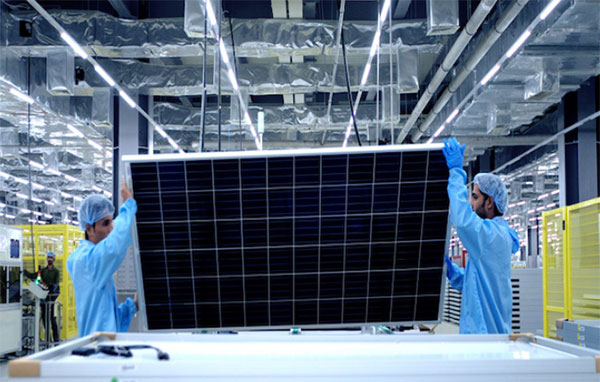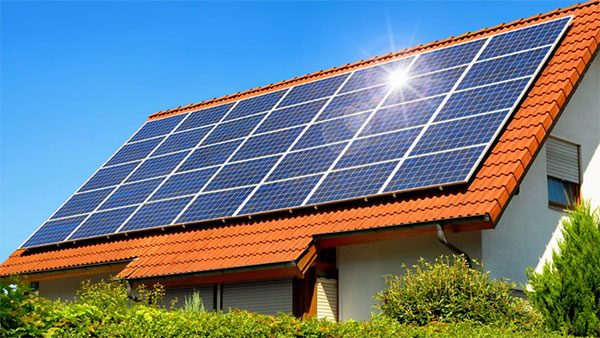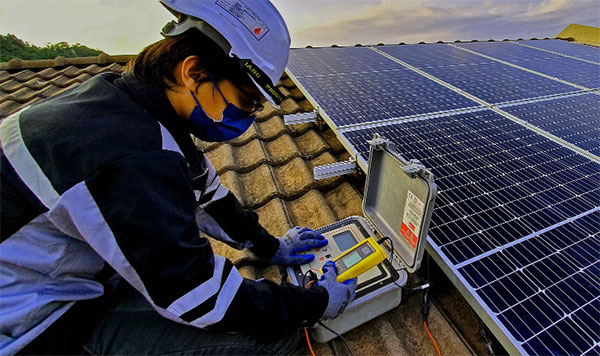Description
Standard residential solar panels typically measure between 65 to 70 inches in length and 39 to 42 inches in width, with power outputs ranging from 250 to 400 watts. Key specifications include wattage, efficiency, and durability. The choice of size and specifications often depends on installation considerations and individual energy needs.

Types of Residential Solar Panels
The push towards sustainable energy has made solar panels a popular choice for residential use. Let's delve deeper into the four major types of solar panels available for homeowners.
Solar Panel Type Comparison Table:
| Type |
Efficiency |
Cost (per panel) |
Lifespan |
Advantages |
Disadvantages |
| Monocrystalline |
20-25% |
$200-$300 |
25-30 years |
Highest efficiency; Long-lasting |
Higher initial cost; More space required |
| Polycrystalline |
15-20% |
$150-$250 |
20-25 years |
Lower initial cost; Adequate for most homes |
Slightly lower efficiency; Shorter lifespan |
| Thin-Film |
10-12% |
$100-$200 |
10-15 years |
Flexible; Lightweight; Aesthetically pleasing |
Lower efficiency; Shortest lifespan |
| Bifacial |
Increases energy yield by 5-20% |
$250-$350 |
Varies, but typically longer than Thin-Film |
Captures sunlight from both sides; Potentially more cost-effective |
Needs specific mounting; Higher initial cost |
Monocrystalline Solar Panels
Recognizable by their distinct black color, these panels are made from a single pure crystal structure. They're known for their high efficiency and longevity, making them a preferred choice for homeowners looking for a long-term solution, albeit at a slightly higher price.
Polycrystalline Solar Panels
These panels, with their blueish hue, are constructed from multiple crystal structures. They offer a middle-ground solution in terms of efficiency and cost, suitable for homeowners with a tighter budget but still looking for a reliable solar solution.
Thin-Film Solar Panels
Different from crystalline panels, thin-film panels are versatile in their application, offering a flexible and lightweight solution. They are perfect for homeowners aiming for aesthetics or have non-standard roof structures, but they do trade-off in efficiency and longevity.
Bifacial Solar Panels
A newer addition to the market, bifacial panels are engineered to harness sunlight from both their front and rear. While they come at a higher initial price, their potential energy yield can make them a cost-effective solution in the long run.
For homeowners, the choice of solar panel will depend on various factors like budget, space availability, and energy needs. It's essential to balance the pros and cons of each type for an informed purchase decision.
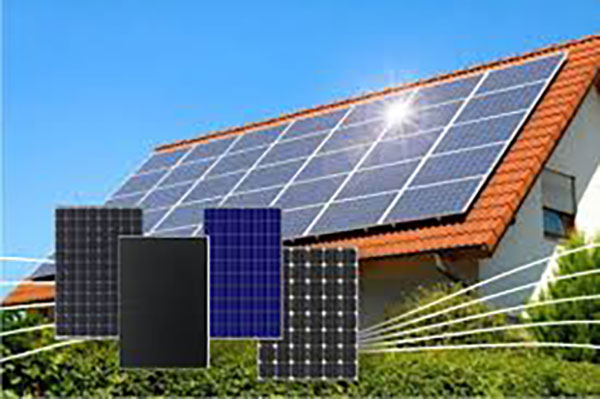
Standard Sizes of Residential Solar Panels
Solar panels have gained widespread adoption in homes due to their environmental benefits and cost savings in the long run. But one question many homeowners
Common Dimensions and Their Applications
Solar panels for residential applications come in several sizes, which primarily depend on the power output and physical size
- 60-cell panels: Measuring approximately 65 inches by 39 inches, these panels are commonly used in residential applications. With a power output ranging between 250 to 300 watts, they're suitable for most homes.
- 72-cell panels: These are slightly larger, usually measuring about 77 inches by 39 inches. With a power output between 350 to 400 watts, they are often considered for larger homes or areas where space isn't
- Smaller panels: For homes with space constraints or unusual roof designs, there are panels that come in sizes like 50 inches by 27 inches with
While these are some of the
standard sizes, it's essential to consider
Factors Influencing Panel Size Choices
Several factors play a role in determining the size of the solar panel one should opt for:
- Roof Space: The available space on your roof will largely dictate the size and number of panels. Larger roofs can accommodate 72-cell panels, while smaller or irregularly shaped roofs might need a combination of standard and smaller-sized panels.
- Energy Needs: Your monthly energy consumption will influence the number of panels and their sizes. If your energy demand is high, you might need larger or more panels to meet your requirements.
- Budget: While solar panels are an investment, initial costs can be a determining factor. Larger panels tend to be more expensive, so homeowners on a tight budget might start with fewer panels or opt for smaller sizes.
- Aesthetic Preferences: Some homeowners prefer a uniform look, opting for panels of the same size. Others might be okay with a mix if it means optimal energy production.
- Local Climate: In areas with less sunlight year-round, homeowners might opt for larger panels or more panels to capture as much sunlight as possible during the available hours.
Selecting the right size of solar panels is crucial. Not only does it impact the initial investment and installation process, but it also determines the efficiency and effectiveness of the solar energy system in the long run.
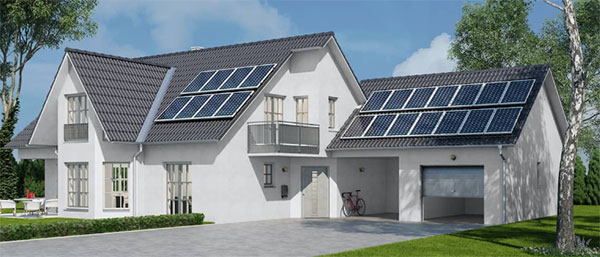
Key Specifications to Consider
When diving into the world of solar panels, the sheer amount of technical jargon and numbers can be overwhelming. However, understanding some key specifications can greatly help in selecting the right solar panel for your needs. Let's break down the crucial specifications one should consider when evaluating solar panels.
Wattage and Efficiency
- Wattage: This refers to the power output of a solar panel under standard testing conditions. Common residential solar panels usually have wattages ranging from 250 watts to 400 watts. A higher wattage indicates that the panel can produce more electricity under the same conditions.
- Efficiency: Efficiency measures the percentage of sunlight that gets converted into usable electricity. For example, if a panel has an efficiency of 20%, it means it can convert 20% of the sunlight it receives into power. Residential solar panels typically have efficiencies between 15% and 22%.
Temperature Coefficient
- Temperature Coefficient: Solar panels, like all electronic devices, are affected by temperature. The temperature coefficient indicates how much the panel's performance will decrease for every degree above 25°C (77°F). For instance, a panel with a temperature coefficient of -0.4% will see its output decrease by 0.4% for every degree above 25°C. The closer this number is to zero, the less the panel's performance is affected by temperature.
Durability and Lifespan
- Durability: The material and build quality of a solar panel dictate its durability. Some panels are designed to withstand hail, high winds, and other environmental factors. It's vital to choose panels that are suited to your local climate and conditions.
- Lifespan: The average solar panel lasts between 25 to 30 years. However, this doesn't mean they stop producing electricity after this period; it simply means their efficiency drops. A panel might still produce 80% of its original output after 25 years, depending on its degradation rate.
Tolerance and Performance Ratio
- Tolerance: This parameter indicates the range within which a panel might overperform or underperform concerning its rated wattage. For instance, a panel with a +5%/-0% tolerance could produce up to 5% more than its rated power but will not produce less.
- Performance Ratio: The performance ratio gives an idea of the real-world performance of a solar panel. It's the ratio of the actual power output to the theoretical power output under perfect conditions. A higher performance ratio indicates that the panel performs well under real-world conditions.
Choosing the right solar panel requires a balance of all these factors. Your energy needs, local climate, budget, and available space will all play a role in determining the best panel for your circumstances. Always consult with a solar expert to ensure you're making an informed decision.

Installation Considerations
Installing solar panels is not just about selecting the right panel based on its specifications. Several other factors come into play to ensure that you get the most out of your solar investment. Let's delve into these installation considerations.
Roof Size and Orientation
- Roof Size: The size of your roof dictates how many solar panels you can fit. A typical solar panel measures around 65 inches by 39 inches, but you also need to account for gaps between panels and space for maintenance. Knowing your roof's square footage can help determine the potential solar output.
- Orientation: Solar panels perform best when they face the sun directly. In the Northern Hemisphere, south-facing roofs are optimal for solar installation. The angle or tilt of the panels also plays a role. Ideally, solar panels should match the latitude of the location for maximum efficiency. For example, if you live at a latitude of 35°, then a tilt of 35° is generally optimal.
Ground-Mounted vs. Roof-Mounted Panels
- Ground-Mounted: These systems are installed directly on the ground using a framework. They offer more flexibility in orientation and tilt, ensuring optimal sunlight capture. However, they do consume yard space and might be more expensive due to the need for trenching and additional mounting equipment.
- Roof-Mounted: These are the most common residential installations. They utilize existing roof space, so they don't take up any additional land area. However, their orientation and tilt are limited to the roof's structure. It's essential to ensure that the roof is in good condition and can bear the weight of the panels.
Inverter and Battery Storage Options
- Inverter: An inverter is a crucial component of a solar system. It converts the DC electricity produced by the solar panels into AC electricity that homes use. There are different types of inverters, including string inverters and microinverters. While string inverters are connected to a group of panels, microinverters are attached to individual panels, allowing for better performance tracking and optimization.
- Battery Storage: Integrating battery storage with your solar system allows you to store excess electricity for later use. This is especially beneficial during periods when the sun isn't shining, like at night or during cloudy days. The size of the battery you need depends on your energy consumption habits. Battery options vary in terms of capacity, lifespan, and price.
Choosing the right setup involves understanding your energy needs, the physical constraints of your property, and your budget. Engaging with a solar installation expert can provide clarity on the best approach tailored to your specific requirements.

Maintenance and Upkeep
Solar panels are known for their durability and long lifespan. However, to ensure they function optimally throughout their service life, regular maintenance and upkeep become crucial. Here's a detailed look at the aspects of maintaining your solar panels.
Cleaning and Inspection
- Cleaning: Dust, pollen, bird droppings, and other debris can accumulate on the surface of solar panels. While a slight layer of dust might not significantly impact the efficiency, it's still advisable to clean the panels regularly. In areas with minimal rainfall, manual cleaning every six months using water and a soft brush can be sufficient. However, avoid cleaning during the hottest parts of the day to prevent any thermal shock to the panels.
- Inspection: Apart from cleaning, a routine inspection of the entire solar system is advisable. Check for any physical damages, loose wires, or corrosion. Also, ensure that the mounting structure remains secure and the inverters display no error messages. It's a good practice to hire a professional for a thorough inspection annually.
Potential Degradation Over Time
- Degradation Rate: Over time, the efficiency of solar panels decreases, a phenomenon known as degradation. On average, solar panels lose about 0.5% to 1% of their efficiency annually. So, after 25 years, a panel might operate at around 80% of its original efficiency. Factors contributing to degradation include UV exposure, temperature fluctuations, and material quality.
- Monitoring System Performance: Regularly monitoring your solar system's output can alert you to any significant performance drops, which might indicate issues beyond typical degradation. Many modern solar systems come with monitoring software that provides real-time data on energy production.
Warranty and Service Considerations
- Manufacturer's Warranty: Most solar panels come with two types of warranties: a performance warranty and an equipment warranty. The performance warranty guarantees a certain level of output for a specified number of years, often 25 years. In contrast, the equipment warranty, which usually lasts for 10 to 12 years, covers manufacturing defects, durability, and other potential issues.
- Service and Repairs: While solar panels require minimal maintenance, other system components like inverters might need replacement sooner. It's essential to understand the warranty and service provisions for all system components. Additionally, some installation companies offer extended service plans or maintenance packages, which can be worth considering for peace of mind.
Maintaining your solar installation ensures you get the most value from your investment. While solar systems are largely "set and forget," periodic checks and proactive care can prolong their lifespan and optimize their performance.






